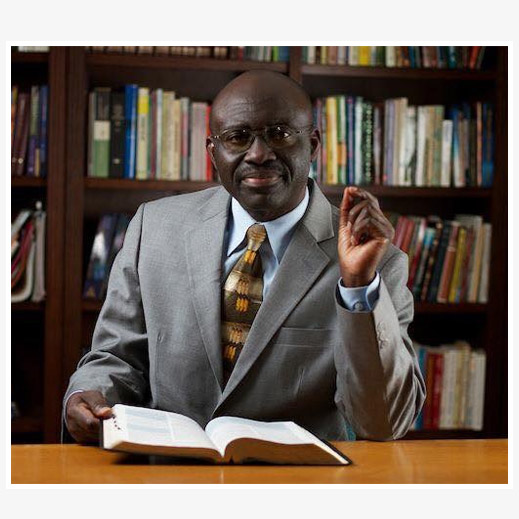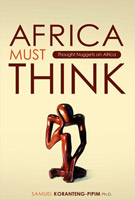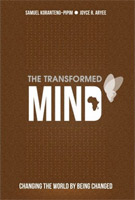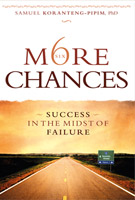0. The Campaign for Women's Ordination--Part 2
THE ROLE OF CHURCH LEADERS & SCHOLARS
[This article is excerpted and adapted from the author’s book Must We Be Silent?]
By
Samuel Koranteng-Pipim, PhD
Director, Public Campus Ministries, Michigan Conference
Introduction
In Part 1, we called attention to the unfortunate tendency by advocates of women’s ordination to trivialize discussions on the subject, by relegating the issue to one’s cultural preference, rather than to one’s fidelity to Scripture. In this second part of our discussion, we shall look at a carefully laid-out political strategy by church leaders in North America to domesticate the unbiblical practice of ordaining women as elders or pastors.
The Politics of Women’s Ordination
In C. Mervyn Maxwell’s article “How Money Got Us Into Trouble,” he followed the money trail, showing how the desire to enjoy U.S.A. IRS income tax advantages got our church into the theological trouble of women’s ordination.[1] In addition to the desire to enjoy United States tax law benefits to ministers, another major factor in the campaign for women’s ordination has been pressure from a relatively small but influential group that has been pushing for women’s ordination during the past thirty or more years.
In response to their pressure, church leaders at the 1975 Spring Council meeting approved the Biblically compromising practice of ordaining women as local elders in the North American Division if “the greatest discretion and caution” were exercised. Later, they succeeded in persuading church leaders at the Fall 1984 Annual Council meeting to reaffirm and expand the 1975 decision, voting to “advise each division that it is free to make provisions as it may deem necessary for the election and ordination of women as local elders.”
Thus, even though the 1975 provision departed from the New Testament model of church leadership that assigns to men, not women, the headship roles of elder or pastor, and even though the world church had not formally approved of the provision at a General Conference session, in 1984 the ordination of women as elders was extended from North America to the world field. [2] Emboldened by their success in influencing church leaders to allow “women elders,” pro-ordination advocates then proceeded to urge the world church in General Conference session to ordain women as pastors, at least in divisions favorable to it. However, at the General Conference sessions both in 1990 (Indianapolis) and 1995 (Utrecht), the representatives of the world church overwhelmingly rejected the pleas to ordain women into the Gospel ministry. The votes were 1,173 to 377 (in 1990) and 1,481 to 673 (in 1995). [3]
In spite of these decisions, proponents of women’s ordination determined upon an all-out campaign, including unilateral ordinations in some influential North American churches and institutions. At the same time that these rebellious ordinations were taking place, advocates were also employing a tactic that had served their cause well in the past—namely, working through church leaders to legislate the un-Biblical practice.
Without doubt, the most subtle, and yet most ambitious, effort by pro-ordinationists to overturn the worldwide decision is the proposal contained in the North American Division’s document “President’s Commission on Women in Ministry—Report.” The document was voted during the October 7-10, 1997 year-end meeting of the North American church leaders. [4] If fully implemented, it will allow women to occupy the highest headship positions of church leadership, including local church pastor, conference president, union president, division president, and even General Conference president.
A Well-Orchestrated Strategy
I summarize below the major strategy that is outlined in the North American Division’s document (“President’s Commission on Women in Ministry—Report”), offering possible reasons behind some of its provisions. Readers familiar with what is going on will recognize that advocates are already energetically implementing these strategies in church publications, print and video media, schools, local churches, conferences, and unions.
1. To make “women pastors” a common fixture in the church, conferences are encouraged “to hire more women in pastoral positions”; they are also requested “to set realistic goals to increase the number of women in pastoral ministry in their field [sic] during the next three years [culminating in the year 2000—the year of the Toronto General Conference session]”;
2. To enlist young people and their parents and teachers in the pro-ordination campaign, Adventist colleges and universities in North America are encouraged “to recruit young women who sense a call to pastoral ministry to pursue ministerial studies”;
3. To get people used to the concept of women serving in the same roles as men, “the NAD edition of the Adventist Review and other general church papers [are to] be asked to publish profiles of women serving in pastoral ministry several times a year”;
4. To ensure that church members become accustomed to seeing “women pastors,” the latter must be given “multiple exposures . . . in congregations throughout the NAD,” including the “use of print and video media” and “indirect portrayals of women with men in creative approaches to pastoral ministry”;
5. To legislate or make official the ordination of women in the Seventh-day Adventist Church without risking another General Conference session defeat, the document encourages the world church “to modify the language” in relevant sections of the current Church Manual and North American Division Working Policy so that wherever the words “ordain” or “ordination” occur they will be replaced by “ordain/commission” or “ordination/commissioning”; this modification makes “commissioning” the functional equivalent of “ordination”;
6. To implement modifications suggested in the Church Manual and North American Division Working Policy, unions and local conferences are encouraged “to promptly conduct commissioning services for those women who are eligible”;
7. To skillfully quiet opposition to women’s ordination/“commissioning” at both the local and higher levels of the church, “the Ministerial Association and/or any appropriate structure” should appoint “an ‘ombudsman’—a person with insight in the system and denominational policies who can provide feedback and guidance when women in ministry encounter conflict with employing organizations, as well as provide mediation if necessary”;
8. To ensure that pro-ordination views are constantly carried in materials produced by the church, “more of the advocacy for women in ministry [should] be channeled through the union papers and other media of mass distribution”; “preparation and dissemination of educational materials in multiple media designed to raise awareness about women in pastoral ministry and the role of women in the church” should be carried out;
9. To silence or censor views opposing women’s ordination, “the Church Resources Consortium [should] monitor and audit all NAD-produced and endorsed materials for compliance with a gender-inclusive model for ministry”;
10. To make dissenting church members feel as though they are out of harmony with the Bible or the official Seventh-day Adventist position, “the division president [should] issue a clear call to the church for gender-inclusiveness at all levels of the church—boards, committees, pastoral assignments, etc.”;
11. To ensure the eventual possibility for all conference, union, or division pastors to be guided by a “woman pastor,” the North American Division is urged to “move with a sense of urgency to include a woman with ministerial background as ministerial secretary or an associate ministerial secretary”;
12. To give Biblical and historical justification for the women’s ordination agenda, there should be “(i) multiple articles in denominational periodicals” and “(ii) a hermeneutics conference by the NAD and/or the GC” to “clarify” the church’s understanding of Biblical interpretation towards the “goals for gender inclusiveness in church organization.”
Actually, most of these strategies had been in operation for many years prior to the voting of the document. Advocates had employed them as they had worked through church leaders in their campaign for ordaining women as elders. But now, for the first time, the document puts these strategies clearly into print.
Of the twelve strategies listed above, the last one seems to be the most daunting. This is because an overwhelming majority of Seventh-day Adventists in North America and other parts of the world are theological conservatives—Bible-believers. As such they will strongly oppose the pro-ordination campaign, unless advocates are able to come up with ways to interpret the Bible (hermeneutics) to justify the ordaining of women as elders or pastors. This is one reason why some North American leaders approached the Seminary, urging it to “do something about Utrecht.” The result of this push from the North American church leaders was the 1998 book Women In Ministry[5] —a work that has been adequately refuted as theologically and historically deficient. [6]
As a result of the above well-choreographed strategies, today:
• pro-ordination church leaders are hiring more “women pastors,” attempting to issue common or unisex ordination credentials to them, and using their office and influence to promote women’s ordination;
• pro-ordination church scholars are trying to indoctrinate Adventist students and seminarians on our Adventist campuses to embrace and promote women’s ordination;
• pro-ordination church editors and publishers are giving publicity to women’s ordination in subtle and not-so-subtle ways;
• pro-ordination church pastors are pushing “women elders” on local churches.
The “Scholarly” Campaign for Women’s Ordination
The initial request for the Seminary book Women in Ministry came from “several union presidents of the North American Division” who, before and during the 1995 Utrecht General Conference session, had urged the North American Division President that there be “no turning back” in their campaign for women’s ordination. [7] When their petition was rejected by the world body at Utrecht, certain leaders in the North American Division began calling for “a clarification of the Adventist theology of ordination, culminating in the ordination of women,” and for steps that would lead to “clear understanding and member education regarding valid Adventist hermeneutical principles [of Biblical interpretation].” [8]
Notice that the call for “a clarification of Adventist theology of ordination” was really a quest for a scholarly work that would “culminate in the ordination of women.” The meaning of “valid Adventist hermeneutical principles” was later made explicit at the October 1995 Year-end Meeting of the North American Division leaders to be an approach to Scripture that would ultimately justify their belief in the Biblical correctness of women’s ordination.
At that October 1995 Year-end Meeting in Battle Creek, just three months after the Utrecht vote, the North American leadership announced that a commission was being appointed to recommend ways to “expand the role of women in ministry,” recognize and deploy the gifts God has given to women, and “affirm women in pastoral and other spiritual ministries.” [9] In their Statement of Commitment to Women in Gospel Ministry, adopted on October 13, 1995, the union presidents of North America also reaffirmed their belief “in the Biblical rightness of women’s ordination” and pledged their support for a clarification of the church’s theology of ordination. [10]
This brief background leads one to conclude that the initial request to the Seminary faculty by “several” of these union presidents for a clarification of the Adventist theology of ordination and for a clear understanding regarding valid Adventist hermeneutical principles, was a search for a scholarly work that would justify the ordination of women. Some three months before the Seminary appointed its Ad Hoc Committee in January 1996 to study issues related to hermeneutics and ordination, some of the North American Division leaders were already convinced of the “Biblical rightness of women’s ordination.”
Why was there a need for the Seminary to clarify the church’s principles for interpreting the Bible when the church already had done so—in the “Methods of Bible Study” document, approved by the church’s worldwide leaders in 1986 in Rio de Janeiro, Brazil? [11] And why was there a need to clarify the church’s theology of ordination, when the church already had articulated its position in the 1988 volume Seventh-day Adventists Believe . . . : A Biblical Exposition of 27 Fundamental Doctrines (pp. 142-150) [12] and our Minister’s Manual (pp. 75-79 [1992 edition]; pp. 83-86 [1997 edition])? [13]
The answer seems obvious. It wasn’t because the church had no valid hermeneutical principles for interpreting the Bible, nor a sound theology of ordination. It already had these. Instead, some of the pro-ordination leaders wanted a theological validation of their stance on ordination. This was the only way they could justify earlier church policy revisions and Church Manual alterations in response to problems resulting from the North American Division’s desire to enjoy United States income tax benefits. [14]
Thus, in the production of the Seminary book Women in Ministry, the interests of pro-ordination leaders and that of pro-ordination scholars kissed each other. Or as the book’s editor later explained, the North American Division leadership, feeling “let down” at Utrecht, wanted the Seminary to “do something about it [the Utrecht vote].” [15]
The conclusion is inescapable. After several years of unsuccessful attempts at legislating the ideology of women’s ordination, the proponents decided that the time had come to try another strategy: the proclamation of the theology of women’s ordination. Using one of the leading and most influential church institutions, the Seventh-day Adventist Theological Seminary at Andrews University, some of the North American Division leaders sought to shift their strategy of women’s ordination from ideology to theology. The Seminary book Women in Ministry is the result of this strategy.
The Seminary volume was an attempt to justify theologically the ideology of women’s ordination, not a quest for an open-minded investigation into what the Bible has to say on a divisive and controversial issue in the church. The Seminary committee’s “dialogue” did not include Andrews University scholars opposed to women’s ordination, some of whom, through their earlier published works, had demonstrated a grasp of the crucial issues in the debate. [16] Though twenty authors collaborated to produce the book, the Seminary Ad Hoc Committee allowed no other viewpoints in the book except those favoring women’s ordination. [17]
Although dissenting scholarly views were not represented in the committee, readers are informed that during its two years of regular meetings, “sensitivity to the positions of others, both for and against women’s ordination was evident.” [18] Lamentably, this is typical of the manner in which the issue has been discussed even in official church publications. [19]
Is it not ironic—and unfortunate—that the views of scholars upholding the long-established Seventh-day Adventist convictions on this question are not always welcome today in church publications and even in the book originating from the Seminary? Whose interest is served when, on unresolved theological issues, opposing views are excluded even when those views are still embraced by the overwhelming majority of the church through official action?
If indeed the intent of the Seminary book is to provide theological reasons to overturn the worldwide decision at Utrecht, some major questions arise: Is it ever right for the Seventh-day Adventist Theological Seminary to allow its prestige and resources to be hijacked for some ideological agenda rejected by the church? If, for instance, a General Conference session votes against homosexuality, can a group of pro-gay theologians in a church institution use the name and resources of the institution to advance their homosexual agenda?
This question is not about the Biblical rightness of women’s ordination, homosexuality, or any other issue. My point here is simply about the responsibility of the church’s leading theological institution to the community of faith at large. What kind of precedent do we set when the Seminary begins to cave in to ideological pressure or “appeals” from some quarters of church leadership?
Women in Ministry would have escaped justifiable criticisms that the Seminary’s name and resources are being (mis)used to promote the ideological agenda of women’s ordination, if it had allowed for opposing views. Since the authors “do not claim to speak for others, either at the Seminary or in church administration,” [20] would it not have been better for the pro-ordination scholars of the Seminary to have published and financed their private views independently (as other scholars both for and against ordination had previously done), instead of using the Seminary’s prestige and resources to gain credibility for their one-sided view?
The Seminary book would also have gained much credibility and, as Prove All Things: A Response to “Women in Ministry” (2000) has convincingly shown, the book would have avoided some of its theological and historical shortcomings if it had allowed for challenges by opposing views. But as we have mentioned earlier, the pro-ordination book was not a quest for an open-minded investigation into what the Bible has to say on the issue. It was a determined attempt to “do something about Utrecht.” This explains why advocates continue to promote the book even though is has been shown to be based on erroneous or questionable reinterpretations of Scripture and Adventist history. [21]
Despite the fact that ordaining women as elders and pastors goes contrary to the teaching of the Bible, the Spirit of Prophecy, the example of the Seventh-day Adventist pioneers, and the decision at two recent General Conference sessions (Indianapolis, 1990, and Utrecht, 1995), advocates continue to push for the practice. As a result of the combined efforts of pro-ordination church leaders and scholars, the latest buzzwords in the campaign for women’s ordination are “women leaders,” “women in leadership,” “women clergy,” and “women empowerment.”
The recent establishment of a “Center for Women Clergy” at the Andrews University Theological Seminary is one more effort to make “women clergy” and “women pastors” theologically acceptable. [22] The church needs to train and mentor more women at the Seminary for the work of ministry. But whether we are aware of it or not, confusing “women in ministry” with “women pastors” or “women clergy” is part of an ongoing campaign to domesticate the liberal-feminist agenda in the church.
In part 3 of this article, we shall show how the liberal-feminist agenda is being carefully pursued.
[1] See C. Mervyn Maxwell’s “How Money Got Us Into Trouble,” in this present volume.
[2] Refer to the minutes of the General Conference Spring Meeting (April 1975) and the General Conference Annual Council (October 1984). Even in the full text of the Annual Council action of 1984—the compromising action that served as a catalyst for those pushing women’s ordination—one will find the cautious measures that church leaders built into their action. Guidelines 3d and 3e are very insightful in this respect. Here is the full text of 272-84GN, the 1984 Annual Council Action:
WOMEN (LOCAL CHURCH) ELDERS—ELECTION AND ORDINATION
VOTED,
1. To reaffirm the Spring Meeting action on the General Conference Committee of 1975 Role of Women in the Church (GCC 75-153).
2. To advise each division that it is free to make provision as it may deem necessary for the election and ordination of women as local church elders.
3. To suggest that the following guidelines be used in the selection and ordination of women as local church elders:
a. The concept should be carefully examined, discussed, and properly accepted at the local church level.
b. If a church contemplates such an action, the entire matter should be discussed and approved by the conference committee after the conference administration has sought counsel from the union leadership. The negotiation between the church and the conference should occur in advance of the final decision and vote by the local church.
c. The action to elect and ordain a woman as a local church elder must not be taken unless a clear consensus exists that the ministry of a woman elder is desirable and even essential to the spiritual well-being of the local church family. It should also be the consensus of the church that a woman elder will be respected as a spiritual leader and soulwinner. The church should also express its belief that there are dimensions of spiritual service and counsel which cannot be properly fulfilled by a male elder.
d. A clear majority of the voting members of the local church must be in favor of the action. The matter should be considered at a specially called church business meeting. Every church member should be given the opportunity to vote on this issue rather than only the few who might be present at a regular meeting where routine items of business are on the agenda. Although preliminary study could be given to this question by the church board, any final action should be taken by the church in a business meeting.
e. Whatever the decision of the church, it should result in unifying the members and not be the source of divisiveness or alienation. The body of Christ, the church, must not be tarnished in any way. In this important issue, as in all things, the name of our Lord and Saviour must be exalted.
[3] One church historian summarizes the discussions at the 1990 and 1995 GC sessions thus: “Delegates to the [1990] world gathering spent nearly twelve hours during three days arguing their opinions about two ordination proposals. The first would permit ordination of women to the Gospel ministry without specifically mentioning women, the second would revise the Church Manual to allow both licensed and commissioned ministers who have been ordained as local elders to conduct marriages with the approval of their division committee. Opponents of ordination of women to the Gospel ministry defeated the first motion by a three to one margin. The second one passed by a three to two margin.
“Although the voting pattern defied neatly drawn lines, it was apparent that the North American Division found itself in the minority. Before the 1995 General Conference in Utrecht, Netherlands, the NAD prepared a proposal that would leave the decision to ordain women to the Gospel ministry in the hands of the world divisions, which meant that women’s ordination would become a policy of the divisions rather than the General Conference. The practical result would allow divisions to permit ordination of women to the Gospel ministry similarly as they permitted licensed or commissioned ministers to baptize or conduct weddings. The proposal would allow enough flexibility at the division level to accommodate differences in policy according to regional social expectations.
“This proposal prompted a short but animated exchange on the floor with arguments falling into three categories. First was the pragmatic view of the North American Division which again argued that because the church could not agree on a theology of ordination the question was essentially a matter of equality between men and women. The second was theological, diametrically opposed to the equality argument, holding that indeed, ordination of women was contrary to Biblical teaching. The third was conclusive—adoption of the North American Division proposal would jeopardize church unity. Many repeated the arguments heard five years earlier. Others saw the proposal as an attempt by the North American Division to sidestep the vote at Indianapolis. In the end, the two negative arguments carried the day and the NAD motion lost—again, by a three to one margin. Few Adventists had changed their minds since Indianapolis.” See Richard W. Schwarz and Floyd Greenleaf, Light Bearers: A History of the Seventh-day Adventist Church (Nampa, Idaho: Pacific Press, 2000), pp. 467, 468.
[4] The full document can be found as appendix D of Prove All Things. It is also available on the Web site of ADVENTISTS AFFIRM: http://www.adventistsaffirm.org.
[5] See n. 21, below.
[6] Nancy Vyhmeister, ed., Women in Ministry: Biblical and Historical Perspectives (Berrien Springs, Mich.: Andrews University Press, 1998). The response to the Seminary book has been provided by Mercedes Dyer, Prove All Things: A Response to “Women in Ministry” (Berrien Springs, Mich.: ADVENTISTS AFFIRM, 2000). See also my Must We Be Silent? pp. 125-297.
[7] See, for example, Alfred C. McClure, “NAD’s President Speaks on Women’s Ordination: Why Should Ordination be Gender Inclusive?” Adventist Review [North American Division edition], February 1995, pp. 14, 15; cf. Gary Patterson, “Let Divisions Decide When to Ordain Women,” Spectrum 24/2 (April 1995) :36-42. For responses to the above view, see the articles by Ethel R. Nelson, “‘No Turning Back’ on Ordination?” and C. Mervyn Maxwell, “Response to NAD President’s Request to Annual Council” in Adventists Affirm 9/1 (Spring 1995) :42-46, 30-37, 67; cf. Samuel Koranteng-Pipim, Searching the Scriptures: Women’s Ordination and the Call to Biblical Fidelity (Berrien Springs, Mich.: ADVENTISTS AFFIRM, 1995), pp. 9-14, 88-90.
[8] After the rejection of the North American Division’s petition at Utrecht, the Pacific Union Conference, one of the largest North American union conferences, took an action they considered to be a road map to eventually ordaining women. Among other things, the union executive committee passed a resolution calling upon the General Conference, through the North American Division, to initiate a process that leads to: (A) “a clarification of the Adventist theology of ordination, culminating in the ordination of women”; and (B) “action steps that lead to a clear understanding and member education regarding valid Adventist hermeneutical principles.” The executive committee of the Pacific Union also released a document affirming the group’s commitment to the goal of women’s ordination and to working towards the day when it will be realized. See “Pacific Union Executive Committee Maps Course for Women,” Pacific Union Recorder, October 2, 1995, pp. 3, 11, emphasis mine.
[9] See the introduction to “President’s Commission on Women in Ministry—Report” reproduced in ADVENTISTS AFFIRM 12/3 (Fall 1998) :13 and in Prove All Things, p. 399.
[10] “A Statement of Commitment to Women in Gospel Ministry from the North American Division Union Presidents,” October 13, 1995, emphasis mine. Two years after the North American Division President’s commission was appointed, its report was formally accepted on October 9, 1997. Among the specific recommendations for “gender inclusiveness in church organization” is an “urgent need to study and clarify the church’s understanding and application of Biblical hermeneutics. This should take the form of: (i) multiple articles in denominational periodicals; (ii) a hermeneutics conference sponsored by the NAD and/or the GC.” See Article XII of the Report of the “President’s Commission on Women in Ministry.” The entire document is worth reading, if one is to capture the scope of the strategies to achieve a gender-inclusive ministry (see Prove All Things, pp. 399-404).
[11] At the 1986 Annual Council meeting in Rio de Janeiro, Brazil, church leaders representing all the world fields of the Seventh-day Adventist Church approved the report of the General Conference’s “Methods of Bible Study Committee” as representative of the church’s hermeneutical position. This document was published in the Adventist Review, January 22, 1987, pp. 18-20, and reproduced as appendix C in my Receiving the Word, pp. 355-362. Generally, loyal Adventists embrace the 1986 “Methods of Bible Study” document as reflecting Adventism’s historic principles of interpretation. For a discussion of how Adventist scholars have reacted to the “Methods of Bible Study” document, see my Receiving the Word, pp. 75-99. For more on the history of Adventist Bible interpretation, see C. Mervyn Maxwell, “A Brief History of Adventist Hermeneutics,” Journal of the Adventist Theological Society 4/2 (1993) :209-226; Don F. Neufeld, “Biblical Interpretation in the Advent Movement,” in Symposium on Biblical Hermeneutics, ed. Gordon Hyde (Washington, D.C.: Biblical Research Institute, 1974), pp. 109-15; George Reid, “Another Look at Adventist Hermeneutics,” Journal of the Adventist Theological Society 2/1 (1991) :69-76.
[12] Seventh-day Adventists Believe . . . : A Biblical Exposition of 27 Fundamental Doctrines (Washington, D.C.: Ministerial Association of the General Conference of Seventh-day Adventists, 1988), esp. pp. 142-150. Produced by some 194 Seventh-day Adventist thought leaders around the world, this “carefully researched” volume is to be received “as representative of . . . [what] Seventh-day Adventists around the globe cherish and proclaim,” and as furnishing “reliable information on the beliefs of our [Seventh-day Adventist] church” (ibid., pp. vii, iv, v).
[13] Seventh-day Adventist Minister’s Handbook (Silver Spring, Md.: Ministerial Association of the General Conference of Seventh-day Adventists, 1997), pp. 83-86. The “Ordination Statement” in the Minister’s Handbook sets forth Adventists’ understanding of the nature, significance, qualifications, and the responsibility of ordination. A note attached to the “Statement of Ordination” reads: “This section reproduces the statement on ministerial ordination prepared by the General Conference Ministerial Association and the GC Biblical Research Institute. The statement received broad input from the world field and went through numerous revisions. It purposely omits the gender issue in ministerial ordination, seeking rather to lay down basic principles by which all ministerial ordination issues can be measured” (ibid., p. 83 [1997 edition]).
[14] For more on the relationship between the issues of income tax benefits and ordination, see [C. Mervyn Maxwell, ed.] “A Very Surprising (and Interesting) History,” ADVENTISTS AFFIRM 12/3 (Fall 1998) :18-23, appearing on pp. 225-230 of Prove All Things; cf. Receiving the Word, pp. 125, 126; p. 140, nn. 43, 44.
[15] The editor of the liberal magazine Adventist Today summarizes the circumstances leading to the production of the Seminary book, as narrated by Nancy Vyhmeister, chair of the Seminary Ad Hoc Committee and editor of the book, at the October 1998 meeting of the pro-ordination group, Association of Adventist Women, held in Loma Linda, California. On the circumstances leading to the feeling of being “let down,” Vyhmeister mentioned that in the wake of the Utrecht defeat of the North American Division petition for women’s ordination, people from opposite ends of the ordination spectrum blamed or praised the Seminary for sending two representatives with opposing viewpoints. She, however, explained that the two professors who spoke at Utrecht (Raoul Dederen and P. Gerard Damsteegt) did not speak for the Seminary: “Those people were invited by ‘someone else,’ and they agreed to speak long before the seminary knew anything about it.” When, therefore, less than a month after Utrecht “several” North American leaders met with the Seminary faculty and told them, “you let us down [at Utrecht]; you’re against women’s ordination,” reports the editor of Adventist Today, “every representative of the Seminary who was attending the meeting insisted that they were not against women’s ordination. In fact, Nancy said, about 90% of the Seminary faculty favor women’s ordination.” What follows is significant: “‘Then do something about it,’ one union president said. Dr. [Werner] Vyhmeister, dean of the Seminary and Nancy’s husband, agreed and said that the Dean’s Council would decide what to do. The outcome of that decision was a fifteen-person committee which [was] formed to study the subject of hermeneutics and ordination” (see Colleen Moore Tinker, “Seminary States Position in Women in Ministry,” Adventist Today, November-December, 1998, pp. 24, 10, emphasis mine). “Doing something about Utrecht” is what the Seminary book is all about, rather than being a quest for an open-minded investigation of what the Bible actually teaches on the subject of women in ministry. Some North American leaders wanted the scholars at the Seminary to speak with one voice in favor of women’s ordination.
[16] See, for example, Samuele Bacchiocchi, Women in the Church: A Biblical Study on the Role of Women in the Church (Berrien Springs, Mich.: Biblical Perspectives, 1987); C. Raymond Holmes, The Tip of an Iceberg: Biblical Authority, Biblical Interpretation, and the Ordination of Women in Ministry (Berrien Springs, Mich.: ADVENTISTS AFFIRM, and Wakefield, Mich.: Pointer Publications, 1994); Samuel Koranteng-Pipim, Searching the Scriptures: Women’s Ordination and the Call to Biblical Fidelity (Berrien Springs, Mich.: ADVENTISTS AFFIRM, 1995). At the time they published their works, Samuele Bacchiocchi was a professor of church history and theology in the religion department of Andrews University; C. Raymond Holmes was the director of the doctor of ministry program and professor of worship and preaching at the Theological Seminary; and Samuel Koranteng-Pipim was a PhD candidate in systematic theology at the Theological Seminary, having served there as a contract teacher in theology and ethics (see also next note).
[17] Of the 20 authors who collaborated to produce the book, one was the Seminary professor who presented the pro-ordination view at Utrecht (Raoul Dederen); but the other Seminary faculty member who presented the opposing view at Utrecht was excluded (P. Gerard Damsteegt, the principal author of the church’s Seventh-day Adventists Believe). Women in Ministry contains an article by an associate professor in the religion department at Andrews University (Keith Mattingly); but a well-known professor in the same department who had published an opposing view (Women in the Church) was left out (Samuele Bacchiocchi). Though not part of the initial committee of 15, other Seminary scholars, including a retired faculty member, were allowed to publish their views in the book (George Knight, Denis Fortin, and Daniel Augsburger); but another equally competent retired faculty member who had earlier challenged women’s ordination (in his The Tip of an Iceberg) was not invited to contribute a chapter (C. Raymond Holmes). Two Seminary students’ works appear in the book (Michael Bernoi and Alicia Worley); but not a single Seminary student opposing women’s ordination was included (at that time Samuel Koranteng-Pipim was a doctoral candidate and had authored the book Searching the Scriptures). It is clear that the Seminary Ad Hoc Committee decided that no other viewpoints should be known in the book except those favoring women’s ordination. The pro-ordination bias of the committee is also evidenced by the manner in which some cite the works and authors of non-ordination publications (see especially Randal Wisbey, “SDA Women in Ministry, 1970-1998,” Women in Ministry, pp. 241, 245, 254, n. 31).
[18] Vyhmeister, “Prologue,” p. 2.
[19] Space limitations will not permit me to document how, prior to Utrecht, official church publications presented mainly pro-ordination views in their pages. But one of the authors of Women in Ministry, despite his pro-ordination bias in chronicling the history of Seventh-day Adventist discussions of the issue, has correctly noted that prior to the 1995 Utrecht General Conference session, “the Adventist Review and Ministry published articles dealing with ordination in which the editors took pro-ordination stands” (Randal R. Wisbey, “SDA Women in Ministry: 1970-1998,” in Women in Ministry, p. 246). For a recent attempt by editors of a church publication to discredit the works of those attempting to uphold the church’s official position, see the editorial comment preceding the article by P. Gerard Damsteegt, “Scripture Faces Current Issues,” Ministry, April 1999, p. 23. For a possible explanation of the pro-ordination bias in church publications, see Articles X and XII in the “[North American Division] President’s Commission on Women in Ministry—Report,” reproduced on pp. 403, 404 of Prove All Things.
[20] Vyhmeister, “Prologue” in Women in Ministry, p. 5.
[21] See, for example, chapters 43, 45, 47, and 49 of my Must We Be Silent?. My detailed response to Women in Ministry is contained in Must We Be Silent? pp. 125-289. Women in Ministry has recently been translated into Spanish, in an apparent effort to change the views of conservative Adventists in South America and other Spanish-speaking regions of the world.
[22] Wendi Rogers, “Center for Women Clergy at Andrews University Provides Support, Mentorship,” Adventist News Network, accessed March 21, 2005, at http://news.adventist.org/data/2004/10/1101845365/index.html.en.









